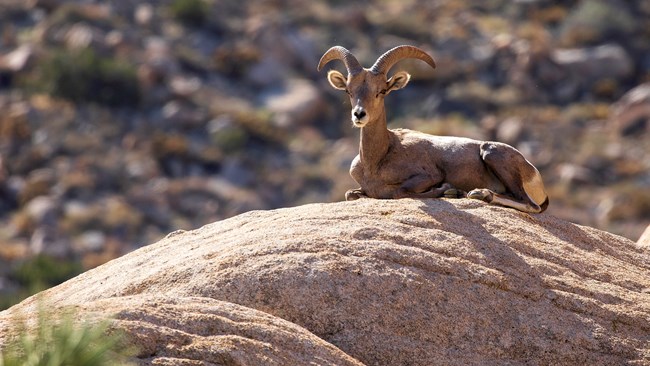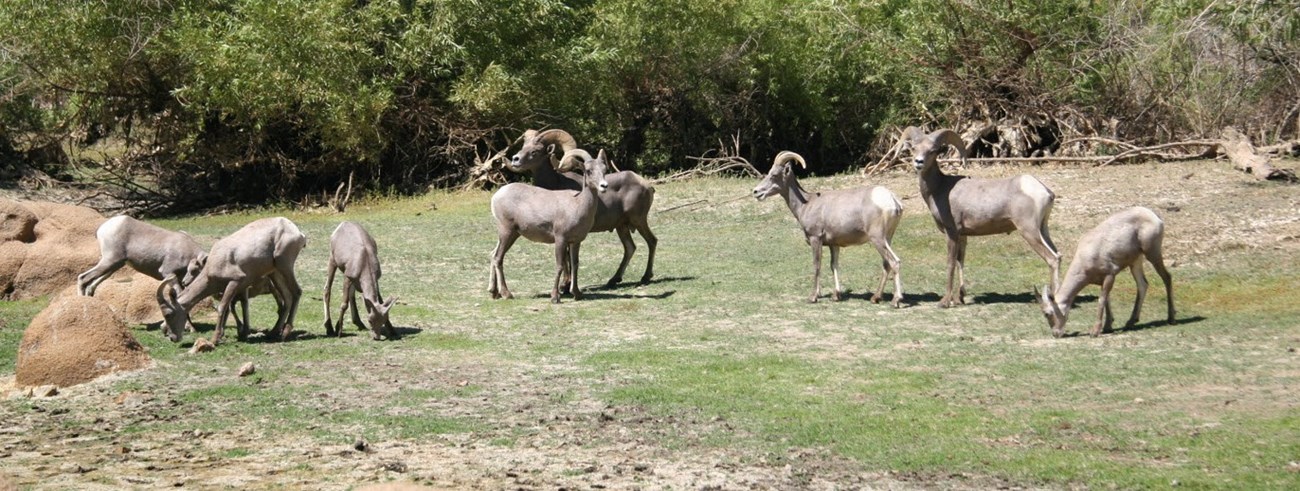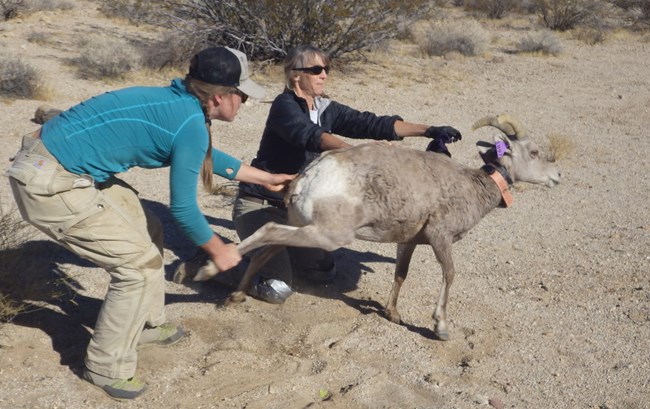Last updated: May 25, 2023
Article
Monitoring Desert Bighorn Sheep

NPS / Preston Jordan Jr.
Background
Desert bighorn sheep are one of the flagship species in Joshua Tree National Park (JTNP). Seeing one of these animals among the rocks can be a highlight of a visit to the park. JTNP is important to the range-wide conservation of bighorn sheep because of the highly protected habitat that the park offers. Studies of bighorn genetics have concluded that JTNP is also important as an open corridor connecting adjacent habitats, and as a source of genetic diversity for sheep populations outside the park.
Several factors, however, threaten the long-term survival of bighorn sheep within the park boundary:
Water availability. Bighorn sheep rely on surface water in springs and oases during the hot summer months. Since 2006, however, the JTNP sheep population has lost 50 percent of its usual summer habitat as springs have dried up. Of 45 documented springs in the park, 6 were dry in 2006; 33 were dry in 2016.
As water has become less available, bighorns have been observed in communities abutting the park, including the towns of Joshua Tree and Twentynine Palms, drinking water from bird baths and pools on private properties. This change in behavior is a concern because interaction with domesticated animals increases the risk that bighorns will contract deadly diseases.
The availability of water in the park region has been manipulated since the early 1920s with dams installed by ranchers, and later (between 1968 and 1982) when JTNP built “guzzlers” to support wildlife. Today, most of those guzzlers are in dilapidated condition.
Human interactions. The park saw visitation more than double from 2013 to 2019, and the number of annual visitors continues to increase. Some of the most popular sites for visitors, like Barker Dam, 49 Palms Canyon, and Lost Palms Oasis, are also prime bighorn habitat, and the presence of humans can deter sheep from approaching water sources.
Disease. A strain of sheep-specific pneumonia has been identified in JTNP (Mycoplasma ovipneumoniae); although the exact origin of the disease is unknown, data suggests that a domesticated goat or sheep spread the disease to bighorn sheep near the park, and those sheep infected JTNP animals. Fatality rates from this disease have reached 90 percent in some Mojave Desert herds. Since the first JTNP outbreak in 2015, the park has identified four additional probable cases of the disease with two known mortalities. It is likely that more infections and mortalities have occurred but were undetected due to a lack of comprehensive monitoring.
Habitat fragmentation and loss. Development projects have shrunk the corridors that connect the JTNP bighorn population to other populations in the American southwest. Anticipating the likely effects of future climate change and recent increases in habitat fragmentation and development in the Mojave Desert, open corridors will be increasingly important to the conservation of bighorn sheep in the decades ahead.

NPS / Michael Vamstad
Monitoring Bighorn Sheep
JTNP is addressing these threats with increased monitoring of park herds. In 2020 and 2021, 16 bighorn sheep were fitted with GPS collars to track their movement patterns and habitat use. The primary goals of the tracking program are to
- Understand sheep habitat use and identify potential threats;
- Document population trends and dynamics including sheep abundance, distribution, health, recruitment, demographics, and evidence of disease;
- Identify the potential impacts on sheep of increased visitor use in preferred habitat; and
- Examine sheep behavior patterns related to water requirements and assess the role of guzzlers and water sources in nearby communities in supporting the park herd.
The monitoring program informs management efforts to conserve bighorn sheep in the park and stabilize declining populations. For example, in 2021, blood samples from six captured animals were tested for the presence of disease; five returned as seropositive for pneumonia. JTNP is seeking support to develop disease transmission models and contingency plans to respond to outbreaks. Meanwhile, biologists are drawing on 20 years of visitor trail use data to assess how increased use of certain trails affects sheep. The park is also reviewing the status of guzzlers and considering repairing or removing them depending on documented use by sheep.

NPS
The monitoring program informs management efforts to conserve bighorn sheep in the park and stabilize declining populations. For example, in 2021, blood samples from six captured animals were tested for the presence of disease; five returned as seropositive for pneumonia. JTNP is seeking support to develop disease transmission models and contingency plans to respond to outbreaks. Meanwhile, biologists are drawing on 20 years of visitor trail use data to assess how increased use of certain trails affects sheep. The park is also reviewing the status of guzzlers and considering repairing or removing them depending on documented use by sheep.
Management Goal
The conservation of JTNP desert bighorn sheep requires comprehensive understanding of the many factors that are important to the health of the animals and to their persistence on the landscape. The goal of desert bighorn sheep management in the park is to support a natural and stable population with minimal intervention, taking into account the current and ongoing changes in climate, visitation levels, and availability of water.
